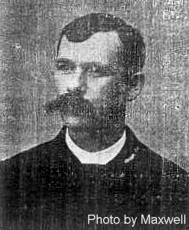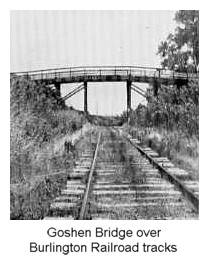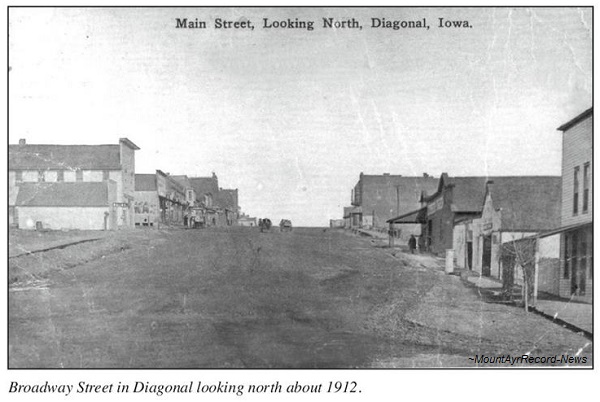|
GOSHEN, RINGGOLD COUNTY, IOWA
Goshen was a village established in 1880 and located in the northeastern part, section 1, of Grant Township. Goshen was named by Henry STAHL for his hometown of
Goshen, Indiana. Goshen operated for a while as a station on the Humeston branch of the CB&Q Railroad.
During its prime, Goshen had a post office, the
Bethel Church, a school located south of the town, a newspaper called The Goshen Gazette, and a physician, Dr. BEMENT.
The Goshen post office, a log cabin located behind the Michael STAHL home, opened in 1872. J. A. BRITTAIN was the
Goshen postmaster in 1875. He ran a dry goods and clothing business which closed in October of 1875. B. F. TALLEY
served Goshen as a postmater later on.
In 1880 a branch line of the Chicago, Burlington &Quincy [CB&Q] Railroad was built. The first trains were calle
Cannon Ball. Later the Humeston and Shenandoah [H&S] came through.
In 1883, two loads
of lumber arrived in Goshen for the construction of a new church in Goshen. This was on the day that President GARFIELD died.
The church was erected at a cost of $1,143.
Businesses in Goshen included:
TODD &INGRAM
General Mdse. | HARTMAN Bros.
Hardware | J. ZARUBA Grocery |
| NELSON Dry Goods | DR. RICHARDSON
Drug Store | SMITH Stock Buyer |
| Blacksmith Shop | BENSON, carpenter | BONHAM Lumber Co. |
| Telegraph Shop | Milling Shop | SMALL Elevator |
Had HERSOM
sorghum mill | WAX &SIMPSON
carpenters | Goshen Gazette
E.C. GARD &A.C. TALLEY |
Goshen was served by two daily mail trains and twelve daily freight trains stopping at the CB&Q Rail depot.
 J. T. TODD came from Kew and bought out INGRAM &Sons Dry Goods. In January of 1884, G. W. MORRISON took charge of the
blacksmith shop. Charles RUBY and Arthur HARTMAN ran a huckster wagon near Goshen.
J. T. TODD came from Kew and bought out INGRAM &Sons Dry Goods. In January of 1884, G. W. MORRISON took charge of the
blacksmith shop. Charles RUBY and Arthur HARTMAN ran a huckster wagon near Goshen. The first funeral in the Goshen
church was that of Mrs. James (Cinthia) RUBY in 1884. The Civil War veterans of Goshen organized the James Conley G.A.R.
Post in 1884. D. D. PRATT traded his farm in Washington Township for J. ZARUBA's
grocery store in 1885. There was a colt show in Goshen, held in 1886. Mr. LOWERY, J. T. WILBUR, and D. I. WILEY were
the judges. Levi LININGER won 1st prize of $15.00.
 The residents of Goshen expected the Chicago Great Western Railroad to cross through their town. This would have created
a great boom for the town and the residents. It was a great disappointment when the tracks were laid along the river bottom, bypassing Goshen.
Then the CB&Q Railroad moved their depot to the crossing in 1889. Due to the location of the tracks and depots,
Diagonal grew up about a mile east of Goshen. This was the beginning of the end for the town of Goshen. The post office
closed in 1889, and the first building moved from Goshen to one mile east, merging with the town of Diagonal on April 1, 1889.
The residents of Goshen expected the Chicago Great Western Railroad to cross through their town. This would have created
a great boom for the town and the residents. It was a great disappointment when the tracks were laid along the river bottom, bypassing Goshen.
Then the CB&Q Railroad moved their depot to the crossing in 1889. Due to the location of the tracks and depots,
Diagonal grew up about a mile east of Goshen. This was the beginning of the end for the town of Goshen. The post office
closed in 1889, and the first building moved from Goshen to one mile east, merging with the town of Diagonal on April 1, 1889.
The Goshen Gazette
Goshen, Ringgold County, Iowa
Thursday, November 17, 1887
Our business men have been consulting together as to the influence the Diagonal will exert on the business interests
of Goshen. The problem is somewhat a perplexing one, and not easily solved, on account of the complex circumstances connected with the case.
We are located 1 and 1 1/2 miles west of the Crossing of the Diagonal and the H. &S. [Humeston and Shenandoah Railroad]
on the line of the other, Knowlton is located 1 mile north of the Crossing. This will make two towns within 2 &1/2 miles of each other on
two different roads in a county that can only support one good town. This will divide the trade and establish an almost unsurmountable barrier against the growth and prosperity of
both. These facts are fully realized by our council who are now counciling with regard to the propriety of establishing a town at the Crossing. We
have been invited to abandon Goshen and move enmasse to Knowlton, but nothing could be gained by such a course. We would
be losers rather by such a move to the the extent of the cost of moving, and the value of our real estate together with a
loss of some valuable territory which Clearfield will gain. We would then be just as we are now, and we can not comprehend how
any advantage could be gained there by. The solution of the problem depends largely upon the combined action of the Diagonaland the H. &S. If the Diagonal is
determined to retain Knowlton as its station in this locality and if the H. &S. deems it inexpedient to co-operate with both
the Diagonal and the people in locating a town near the Crossing then the absolute certainty is established that Goshen will remain
as it is and that Knowlton will never amount to anything. Goshen as a rule will retain its present territory and
patronage, while Knowlton, surrounded as it is by a poor agriculture county and hemmed in by towns with in a few miles on
every side, can not possibly amount to much as a town. If the H. &S., the Diagonal and the people co-operate in this
matter by locating a town at the Crossing where it out to be from any stand-point of reasoning, a thriving, prosperous, city is just as certainly assured, as such a
course is pursued. We would then combine the territories of the 2 towns surrounding us. We would have a direct outlet
to all points of the compass. The combinations and the advantages of transportation facilities would create a confidence in the future
success of the town and draw to us people and capital, that will drift elsewhere if we remain as we are now. There is no
better class of business men then those of Goshen and in this matter they are sincere and in dead earnest, and in the solution
of this problem the people of Goshen and many have arrived at on conclusion and that conclusion is final. It is this, Goshen will move to
the Crossing if the proper inducements are proffered but it will never move to Knowlton. The Crossing became the town of Diagonal.
Both Goshen and Knowlton moved to Diagonal later on.
The Ringgold Record
Mount Ayr, Ringgold County, Iowa
April 13, 1889
GOSHEN ON THE MOVE
Goshen is on the move. Charles DAYTON has moved his dwelling to Diagonal and Had HERSOM is moving all his buildings to this
new town. NOTE: Diagonal offered town lots free to those who would move their homes and buildings in
from Goshen and Knowlton.
The Ringgold Record
Mount Ayr, Ringgold County, Iowa
May 2, 1889
THE BIG MOVE
Goshen is now virtually on wheels and moving toward the crossing. Such unity and harmony in a move of this kind is rarely met.
The cry is "Ho to the crossing." Knowlton has a lively and thriving city and has no notion of moving to a large city.
The last train passed through the area of Goshen on December 31st of 1945.
Ringgold Roots
Ringgold County Genealogical Society
Mount Ayr, Ringgold County, Iowa
Vol. 1, Pp. 14. July, 1980
RINGGOLD ROOTS SALUTES GOSHEN
  Goshen was established in 1880 and continued active for 10 years, until 1890. It was located 1 3/4ths mile west of
Diagonal, or 12 miles from Mt. Ayr. The population around 1887 was about 150. The name "Goshen" was selected by Henry STAHL,
who had come from Goshen, Indiana, in 1856. The first postmaster was Michael STAHL and he ran the post office in his home
until 1881. In 1880 a branch line of the Chicago Burlington and Quincy Railroad was built. First trains were called Cannon
Balls, and later the H&S (Humeston &Shenandoah) which continued to operate until December 1945. Goshen was established in 1880 and continued active for 10 years, until 1890. It was located 1 3/4ths mile west of
Diagonal, or 12 miles from Mt. Ayr. The population around 1887 was about 150. The name "Goshen" was selected by Henry STAHL,
who had come from Goshen, Indiana, in 1856. The first postmaster was Michael STAHL and he ran the post office in his home
until 1881. In 1880 a branch line of the Chicago Burlington and Quincy Railroad was built. First trains were called Cannon
Balls, and later the H&S (Humeston &Shenandoah) which continued to operate until December 1945.
They had 2 general stores,
and D. D. PRATT and PRATT have the two stores. The first general store was built by J. T. TODD and he was postmaster until
1883, then B. F. TALLEY succeeded him. One hardware store first kept by HARTMAN and Brothers and then HARTMAN and BAILEY. L. L.
BAUMANN had the lumber yard; MILLER brothers bought grain, and G. W. MORRISON was proprietor of the hotel. They also had
2 blacksmith shops. Dr. BEMENT was the physician. A log chuch was built in the Bethel Cemetery south of Goshen, serving the
Methodists and other residents until a frame church was built in Goshen in 1881, and moved to Diagonal in 1890. The large
brass bell from the belfry of the Goshen Church was installed on a tower beside the Diagonal Methodist Church nearly 100
years after it's purchase for the Goshen Church. They even had a newspaper for a while, entitled The Goshen GAZETTE.
Did you know all that? "Land-A-Goshen" I didn't! Information taken from the Diagonal Centennial 1878-1978 book and
Biographical &Historical Record of Ringgold and Decatur Counties, Iowa.

Mount Ayr Record-News
Mount Ayr, Ringgold County, Iowa
Thursday, October 22, 2015, Page


By Mike AvittSome of the buildings in this postcard picture may have been moved to Diagonal from Goshen. I don't have any Goshen photos so I ran
this one. Goshen, as you know, was located one and one-quarter mile west of present-day Diagonal. When the Chicago, St. Paul, and Kansas City Railroad (later
called the Chicago Great Western) built a mainline track east of Goshen, and under the Humeston &Shenandoah, the town moved its buildings to the crossing
in 1889. Goshen was a post office in the Bethel community beginning in 1872, J. T. Todd being the first postmaster. When the Keokuk &Western built a
branch line in 1882, the Humeston &Shendoah, through Ringgold County, a town was platted along the line and the Goshen Post Office moved to the new town.
The town grew and businesses sprang up, including a newspaper. I once wrote that no surviving Goshen newspapers existed, but, fortunately, I was wrong. Liz
Wiley loaned me her copy of the October 6, 1887 Goshen Gazette. In this newspaper, the publishers are listed as Gard and Pratt. I believe this
was Stephen J. Gard and D. D. Pratt. Mr. Gard is listed as a publisher of the Goshen Gazette in a 1970 newspaper article written by Mildred Turnbull. D. D.
Pratt was once owner of the Ringgold Record so I'm guessing he was the publisher listed here. George Morrison is listed as the proprieter of the
Goshen House, a hotel. He was also the village blacksmith beginning in 1884. When Goshen moved to the
crossing, Mr. Morrison built a new hotel rather than try and move the old one. An advertisement in an April 1893 Twice-A-Week News newspaper says the
hotel is still being run by Mrs. G. W. Morrison. L. L. Bonham is advertised as the Goshen lumberman. He also was erecting a new lumber shed in the summer
of 1889. Bonham came to Ringgold County in 1882 from Clarke County, Iowa. But not everyone from Goshen moved to Diagonal in the summer of 1889. Mac Parr
is listed as the contact for the International Order of Good Templars, Goshen Lodge 40. He ended up going to Knowlton and doing business. And not everyone
moved in 1889. The Goshen Methodist Church was still sitting in Goshen until the fall of 1890 when it was dismantled and moved to Diagonal. The book,
"Biographical and Historical Record of Ringgold and Decatur
Counties (1887)," says the population of Goshen was about 150. I'm guessing that is an 1886 estimate.
By 1896, Diagonal had over 300 residents. And I see many more Bohemian names connected with Diagonal than I did with Goshen. The heart of the Bohemian
community was a few miles south of Diagonal. The Keokuk &Western put in side tracks at Diagonal and by July 11, 1889, all railroad business that had been
done at Goshen was now being done at Diagonal. The town of Goshen lasted from 1882 to 1890 and this was before photographs became common in Ringgold County.
Also, Goshen disappeared quickly, unlike Caledonia or Knowlton which lingered for decades. This makes research more difficult. I have some good news,
though. Liz Wiley has written a new Diagonal history book and I have already ordered mine. It should be out soon.
Photograph courtesy of Mount Ayr Record-News
Transcription by Sharon R. Becker, October of 2015
SOURCES:
Various articles from Mount Ayr Record-News and The Diagonal Progress
Diagonal, Iowa Centennial History: 1888-1988 Pp. 5-10. 1988.
Compilation by Sharon R. Becker, updated May of 2010; updated October of 2015
Goshen Town Plat, 1881
Great Land O' Goshen!, by Lawrence P. Todd
Goshen Playbill, 1881
Goshen History, by Mildred Wiley Turnbull
Knowlton Lives Again, includes Goshen


| 

